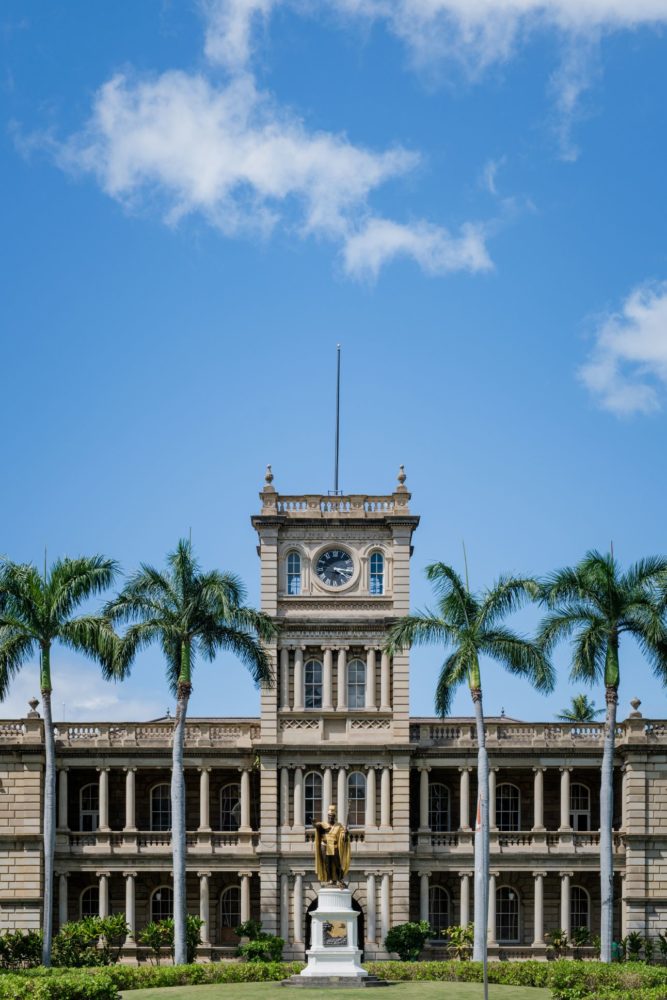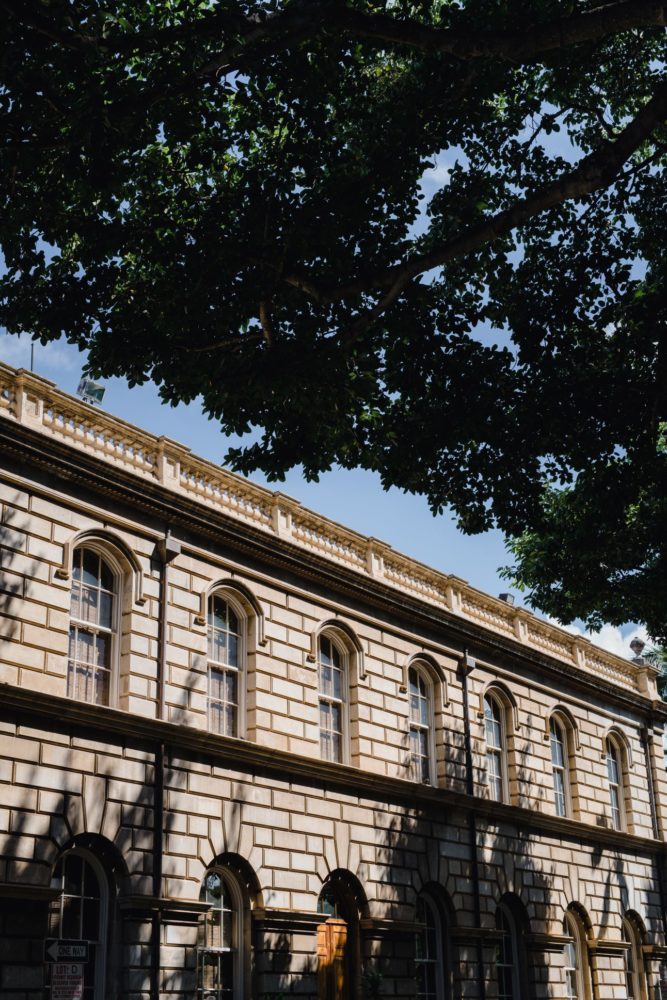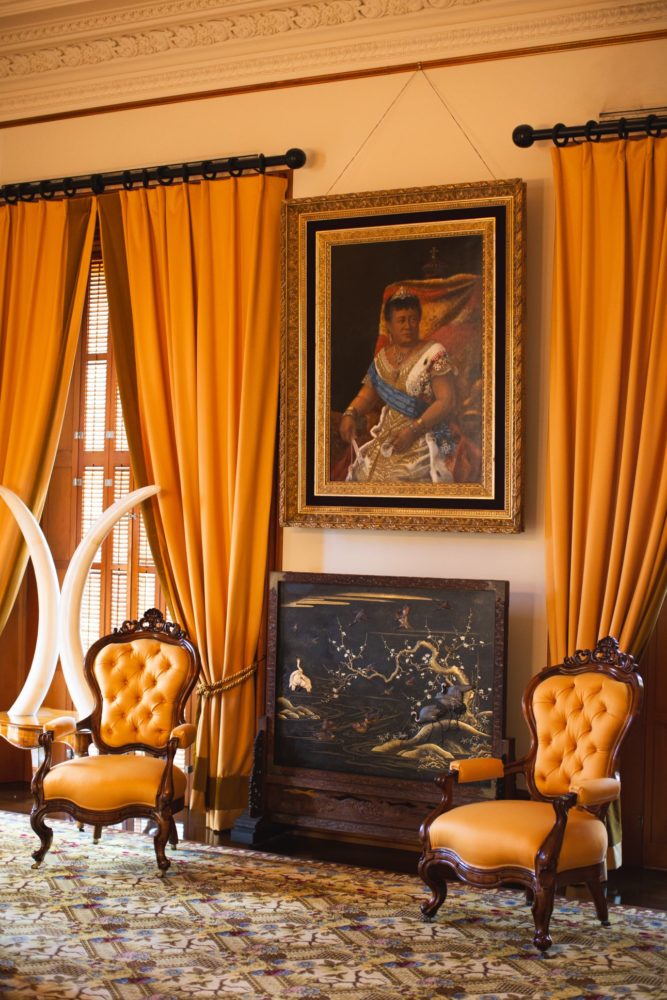Historic preservation work requires attention to detail, problem-solving skills, and respect for the work done before. Glenn Mason heeds the call.
Growing up in Honolulu and watching it change over the past 35 years, there are few built environments that have stayed the same. ʻIolani Palace, its grounds and surrounding buildings are different.
For a walk through this area, I may start at Washington Place, a sleek white residence with a large lānai, where Queen Liliʻuokalani was arrested in 1893. I’ll stroll towards the palace, passing the iron fence and gates to enter its expansive lawn, where I see ʻIolani Barracks, built in 1871, and Keliʻiponi Hale, built in 1883 for the coronation of King Kalākaua.
I exit the palace grounds, cross King Street, and walk past Aliʻiōlani Hale and the King Kamehameha statue. Across Punchbowl Street, Kawaiahaʻo Church stands tall with fitted coral blocks, and on its grounds sits Lunalilo’s tomb, a concrete mausoleum with a gothic archway at its entrance.
All of these structures were completed in the 1800s, and while I may see signs that it is 2021—pedestrians wearing N95 masks and carrying iPhones—I am transported to scenes from the past: It’s 1864 and Kamehameha V is debating the constitution at Kawaiahaʻo; 10 years later, the legislature and judiciary are setting up at Aliʻiōlani Hale; King Kalākaua’s 1886 jubilee is being celebrated with hula on the lawn; the Hawaiian flag is lowered during the 1893 Overthrow, which is reenacted by Hawaiian activists at the palace every Fourth of July.
“These are actual, physical connections to our history,” says Glenn Mason, the president of Mason Architects, which focuses on historic preservation. Mason, who was born and raised in Hawaiʻi, graduated with a Master of Architecture from the University of Michigan in 1974.
You May Also Like: Decolonizing Hawaiʻi’s Spaces


He first started working in 1975 as a drafter with architect Geoffrey Fairfax, who had just three years earlier developed the architectural guide for the ʻIolani Palace restoration. Mason then worked for Vladimir Ossipoff for almost two years, although not on restoration work. In 1978, he started working for architect Charles “Ty” Sutton, who took over the preliminary work done by Fairfax on many historic buildings after he retired in 1976. While at Sutton’s office, Mason was tasked with restoring the ʻIolani Barracks and Huliheʻe Palace on Hawaiʻi Island.
“That kind of work fits my mentality,” says Mason. In late 1980, Mason left Sutton and started working with Spencer Leineweber, who also worked on historic restoration. They became partners in 1984, and he eventually took over, renaming the firm Mason Architects. Since then, he has had his hands on all these monarchy buildings.
There is a difference between saving a building and historic restoration. While there is nothing wrong with the former, Mason says, his work tells a specific story about a place and a time. This might require removing parts of a building that were added at some point after it was completed or adding back things that were removed.
ʻIolani Palace was finished in 1882, during the reign of King Kalākaua. But it didn’t remain static. In 1886, Kalākaua converted the palace from gas lamps to electric lights. In 1891, it became the home of Queen Liliʻuokalani, and after the Overthrow, it was where she was imprisoned. The Provisional Government moved in and the palace continued to be used as the seat of government—by the territory and state—until 1969.


These are actual, physical connections to our history.
Glenn Mason


Throughout that time, rooms were rearranged, furnishings were sold, wooden structures were added to the palace’s sides to expand the space, and it was severely neglected. When restoration efforts began upon relocation of the government to a new capitol building in 1969, it had been decided to restore the palace back to what it would have looked like between 1886 to 1893. ʻIolani Palace would once again tell the story of the last two monarchs of the Hawaiian Kingdom.
It would have been logistically difficult to restore the palace back to its original 1882 state, says Mason, because that would have required converting it to gas lamps, but it also would have excluded Liliʻuokalani’s era. Mason said he is relieved the architects working before him removed the obtrusive wooden structures added to the side of the palace, making it look as it did when the queen reigned.
After the first phases of restoration on the palace were complete, it sat empty. Using historic photos, Mason completed drawings in 1978 of furniture, like the settee that sat in the middle of the Throne Room, which aided in repairing or reconstructing items.
“The palace is more than just that building, it is the entire site,” Mason says. The 10-acre site is surrounded on all four sides by a low wall topped with a green-painted fence with two layers of gilded gold spearheads, which was completed in 1892. At each of the four main entrances are four pillars and ornate gates that display the coat of arms of the Hawaiian Kingdom. In 1918, the Territorial government removed the inner pillars and gates to widen the road to accommodate cars, so in 1982 Mason reconstructed the pillars and returned the gates to how they looked in the 1800s, when horse-drawn carriages were often used by the Hawaiian royalty.
You May Also Like: At Hawaiʻi’s State Archives, an Enduring ʻIke


Preservation work requires attention to detail, problem-solving skills, and respect for the work done before, says Mason. Before restoration begins, a historic structures report must be completed.
This involves researching every available record: photos, letters, plans, taxes, property documents, and fire maps. Mason has worked on buildings that were completed before the 1830s, when photography was invented, which he says makes things extremely difficult to determine.
With his calm demeanor, Mason doesn’t express his passion for historic restoration in the tone of his voice, but in his excitement when he talks about the individual challenges that each project presents, the nuanced philosophies behind the choices he makes, and how he figured out how to fix a building or a part of it.
For instance, before prefabrication became widespread, it wasn’t possible to just go to the store and buy light fixtures or railings off the shelf; everything was individually made.
In order to figure out how to restore anything, Mason must first dissect it, which allows him to determine how it was originally constructed. Each project is a puzzle presenting unique challenges that can’t be fixed with modern materials. This is where Mason’s creativity comes into play, as he solves each individual problem.


Despite his indisputable skill, Mason is extremely humble, and he is definitely bashful about the idea that this story is being written about him.
But as we talk, I realize this humility is foundational for his job, as respect for the work that came before is paramount. If he has done his job well, he says, then his work will be invisible to the eye.
“I’m successful when you can’t tell I’ve been there,” he says. “If you have respect for the work that was done before, you want to have that work show up—not your work.”
Along with restoring old buildings, Mason also makes old structures more appropriate for modern use, which may involve adding fire sprinklers or air conditioning.
At the Bishop Museum, Mason added these features to Pauahi Hall, which was built in 1889, and the Pacific Hall, built in 1893. For the palace, it has been debated whether a fire suppression system should be added, but it would be very hard, if not impossible, to hide the lines.
Many old places were inefficiently designed, and some people say they should be demolished to make room for environmentally friendly structures, but Mason argues historic preservation is sustainable.
“I think sustainability and preservation go hand in glove,” says Mason. “I personally think saving a building is sustainable. Let’s just figure out how to make it work a little better from an environmental point of view.” It’s also important to save the buildings, he says, as they hold the memories of Hawaiʻi. “They tell a story of what it was like here,” Mason says. “There’s so much new stuff it’s easy to lose sight of our history.”

